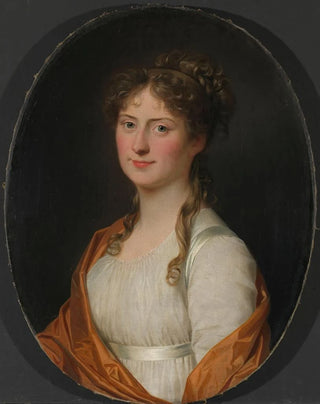Art print | Portrait of a woman - Jens Juel


View from behind

Frame (optional)
Portrait of a Woman - Jens Juel – Captivating Introduction
The "Portrait of a Woman" by Jens Juel is a work that embodies the elegance and subtlety of 18th-century portraiture. This painting, both intimate and universal, invites the viewer to delve into the world of a woman whose identity remains mysterious. The soft light and delicate nuances of the painting create an atmosphere of serenity, while the expression on the face seems to tell a personal story, both unique and timeless. Through this portrait, Juel manages to capture not only the physical features of his model but also the very essence of her being, making this work a true masterpiece of Nordic painting.
Style and uniqueness of the work
Jens Juel's style is distinguished by its realistic approach and attention to detail. In the "Portrait of a Woman," each brushstroke is carefully considered, contributing to a rich texture that brings the canvas to life. The drapery of the dress, the reflections in the hair, and the delicacy of the facial features are all elements that testify to the artist's exceptional talent. The color palette, soft and harmonious, plays a fundamental role in the atmosphere of the piece. Pastel tones, mixed with more intense touches, allow for a subtle contrast that highlights the beauty of the model. Juel excels in the art of light, using delicate shadows to sculpt the face and create a sense of depth, making the portrait all the more lively and engaging.
The artist and his influence
Jens Juel, born in Denmark in 1745, is often regarded as one of the greatest portraitists of his time. Trained at the Royal Danish Academy of Fine Arts, he successfully combined tradition and innovation, influencing many artists who followed him. His style, marked by a particular sensitivity to the psychological nuances of his models, helped redefine the genre of portraiture. Juel also played an important role in the development of Danish painting, integrating elements of Neoclassicism while maintaining a deeply personal approach. His works are today recognized for their ability to capture not only

Matte finish

View from behind

Frame (optional)
Portrait of a Woman - Jens Juel – Captivating Introduction
The "Portrait of a Woman" by Jens Juel is a work that embodies the elegance and subtlety of 18th-century portraiture. This painting, both intimate and universal, invites the viewer to delve into the world of a woman whose identity remains mysterious. The soft light and delicate nuances of the painting create an atmosphere of serenity, while the expression on the face seems to tell a personal story, both unique and timeless. Through this portrait, Juel manages to capture not only the physical features of his model but also the very essence of her being, making this work a true masterpiece of Nordic painting.
Style and uniqueness of the work
Jens Juel's style is distinguished by its realistic approach and attention to detail. In the "Portrait of a Woman," each brushstroke is carefully considered, contributing to a rich texture that brings the canvas to life. The drapery of the dress, the reflections in the hair, and the delicacy of the facial features are all elements that testify to the artist's exceptional talent. The color palette, soft and harmonious, plays a fundamental role in the atmosphere of the piece. Pastel tones, mixed with more intense touches, allow for a subtle contrast that highlights the beauty of the model. Juel excels in the art of light, using delicate shadows to sculpt the face and create a sense of depth, making the portrait all the more lively and engaging.
The artist and his influence
Jens Juel, born in Denmark in 1745, is often regarded as one of the greatest portraitists of his time. Trained at the Royal Danish Academy of Fine Arts, he successfully combined tradition and innovation, influencing many artists who followed him. His style, marked by a particular sensitivity to the psychological nuances of his models, helped redefine the genre of portraiture. Juel also played an important role in the development of Danish painting, integrating elements of Neoclassicism while maintaining a deeply personal approach. His works are today recognized for their ability to capture not only






